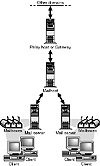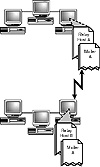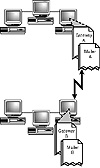
Figure 1-1 A typical electronic mail configuration.
| Previous | Table of Contents | Next |
Refer to the chapters in this part if you need to set up a new mail service or expand an existing one.
This part describes the Solaris 2.x mail services in four chapters. Chapter 1 describes the components of the mail service, defines mail service terminology, and explains how the programs in the mail service interact. Chapter 2 describes several common mail configurations and provides guidelines for setting up each configuration. Chapter 3 describes how to set up and administer mail services. Chapter 4 describes the sendmail configuration file and explains how to customize it if you need a more complex configuration file for your mail system.
THE SUNOS? 5.X MAIL SERVICES USE THE SUNOS 4.X SENDMAIL MAIL-ROUTING PROGRAM-- which came from 4.3 BSD UNIX--with some minor modifications; SunOS 5.x does not use the AT&T mail-routing program. If you are familiar with SunOS 4.x mail services, you will be able to set up and administer mail services for SunOS 5.x system easily. You will also find that it is easy to administer mail services on a network that has some systems running SunOS 4.x system software and others running SunOS 5.x system software. To help you find the modifications, information that is new to the SunOS 5.x sendmail program has an icon in the margin and is labeled SVR4.
As system administrator, you may need to expand an existing mail service or set up a new one. To help you with these tasks, this chapter defines mail services terminology and describes the components of the mail service.
This section defines the following terms and describes how they are used in the mail services:
A mail configuration requires a minimum of three elements, which can be combined on the same system or can be provided by separate systems: a mailhost, at least one mail server, and mail clients. When you want users to be able to communicate with networks outside of your domain, you must also have a relay host or a gateway.
Figure 1-1 shows a typical electronic mail configuration that uses all four elements. Each of these elements is identified and described in the following sections.

Figure 1-1 A typical electronic mail configuration.
A relay host is a system that runs at least one mail-related protocol, which is called a mailer. Each mailer specifies a policy and the mechanics to be used when delivering mail. The relay host handles unresolved mail--mail with an address for which sendmail could not find a recipient in your domain. If a relay host exists, sendmail uses it for sending and receiving mail outside of your domain.
The mailer on the sending relay host must be compatible with the mailer on the receiving system, as shown in Figure 1-2. You specify the mailer for your domain in the sendmail.cf file. The default sendmail.cf file defines several mailer specifications, such as smartuucp, ddn, ether, and uucp. You can define others.

Figure 1-2 Compatible mailers on a relay host and on the receiving system.
The relay host can be the same system as the mailhost, or you can configure another system as the relay host, as shown in Figure 1-4. You may, in fact, choose to configure more than one relay host for your domain if you have several connections outside of your site. If you have uucp or Internet connections, configure the system with those connections as the relay host.

Figure 1-4 The relay host and the mailhost can be on the same system or on different systems.
A gateway is a system that handles connections between networks running different communications protocols, as shown in Figure 1-3. A relay host and the system it is connected to must use matching mailers. A gateway can handle connections to systems with unmatched mailers. You must customize the sendmail.cf file on the gateway system, which can be a difficult and time-consuming process.

Figure 1-3 A gateway can handle connections between different communications protocols.
If you have to set up a gateway, find a gateway configuration file that is close to what you need and modify it to fit your situation. For example, you can modify the default /etc/mail/main.cf file to use on a gateway system.
| Previous | Table of Contents | Next |